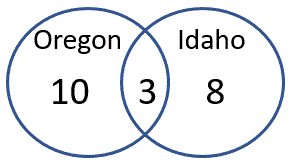| Problem |
Solution |
|
4) In Josie's class there are 28 students. 13 have been to Oregon, 11 have been to Idaho, and 3 have
been to both. How many students have not been to either Oregon or Idaho? |
Method 1: Use a Venn diagram
 Your Venn diagram should look like this:
Your Venn diagram should look like this:
1. Draw the numbers in the diagram and then add the 3 components = 10 + 3 + 8 = 21 students have been to Oregon, Idaho or both.
2. Subtract this from 28 - 21 = 7 students.
Method 2: Use logic:
1. If 13 students have been to Oregon and 3 of those also have been to Idaho, then 10 have been to Oregon only.
2. If 11 students have been to Idaho and 3 of those also have been to Oregon, then 8 have been to Idaho only.
3. Add these two to the number that have been to both =
10 + 8 + 3 = 21 students
4. Subtract this from the total: 28 = 21 = 7 students.
|
|
5) I'm thinking of a positive number. If I square it and then subtract 65, I get the same answer as
when I multiply my number by 8. What is my number? |
Use x for your number.
1. Write an expression for "square it and subtract 65" =
x2 - 65
2. Write an expression for "multiply my number by 8" =
8x
3. Set these equal to each other and solve.
x2 -65 = 8x
x2 - 8x - 65 = 0.
Use the quadratic formula: (constants: a = 1, b = -8, c = -65)
x = 8 ± √
8 2 -
(4) (1) (-65)
2
x = 8 ± √
64 +260 So:
2
x = 8 ± 18 x = 4 + 9 = 13
2
Note: x = -5 is also a solution to this equation, but the problem asked for a positive number!
|
|